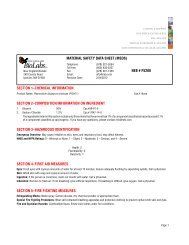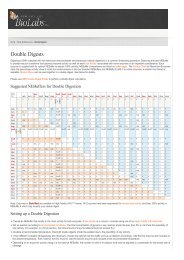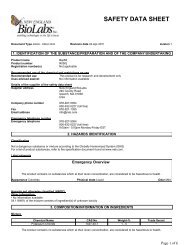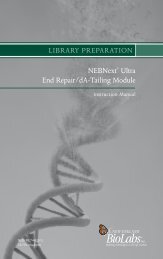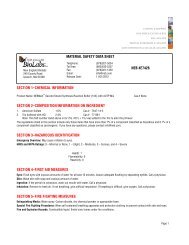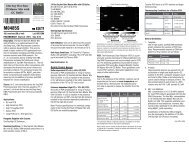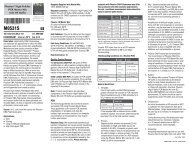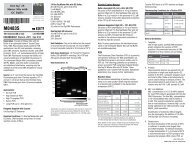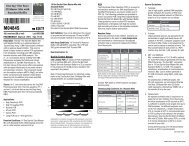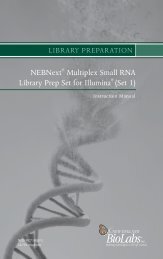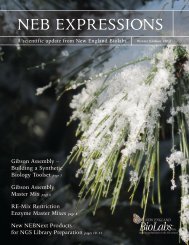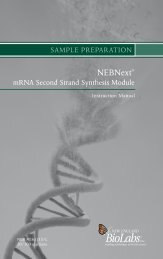One Taq™ Hot Start 2X Master Mix with GC Buffer M0485 msds
One Taq™ Hot Start 2X Master Mix with GC Buffer M0485 msds
One Taq™ Hot Start 2X Master Mix with GC Buffer M0485 msds
Create successful ePaper yourself
Turn your PDF publications into a flip-book with our unique Google optimized e-Paper software.
NEW ENGLAND<br />
® BioLabs Inc.<br />
New England Biolabs<br />
240 County Road<br />
Ipswich, MA 01938<br />
SECTION 1–CHEMICAL INFORMATION<br />
CLONING & MAPPING<br />
DNA AMPLIFICATION & PCR<br />
RNA ANALYSIS<br />
PROTEIN EXPRESSION & ANALYSIS<br />
GENE EXPRESSION & CELLULAR ANALYSIS<br />
Product Name: <strong>One</strong> Taq <strong>Hot</strong> <strong>Start</strong> <strong>2X</strong> <strong>Master</strong> <strong>Mix</strong> <strong>with</strong> <strong>GC</strong> <strong>Buffer</strong> Cas.# None<br />
SECTION 2–COMPOSITION/INFORMATION ON INGREDIENT<br />
1. Glycerol 10% Cas.# 56-81-5<br />
2. Dimethyl Sulfoxide 10% Cas.# 67-68-5<br />
The ingredients listed in this section include only those items that have more than 1% of a component classified as hazardous and 0.1% of a<br />
component classified as carcinogenic. If you have any questions, please contact info@neb.com.<br />
SECTION 3–HAZARDOUS IDENTIFICATION<br />
Emergency Overview: Warning: May cause irritation to skin, eyes, and respiratory tract, may affect kidneys, blood and liver.<br />
HMIS and NFPA Ratings: 0 – Minimal or None, 1 – Slight, 2 – Moderate, 3 – Serious, and 4 – Severe<br />
SECTION 4–FIRST AID MEASURES<br />
Health: 1<br />
Flammability: 1<br />
Reactivity: 0<br />
Eyes: Flush eyes <strong>with</strong> copious amounts of water for at least 15 minutes. Assure adequate flushing by separating eyelids. Call a physician.<br />
Skin: Wash skin <strong>with</strong> soap and copious amount of water.<br />
Ingestion: If the person is conscious, wash out mouth <strong>with</strong> water. Call a physician.<br />
Inhalation: Remove to fresh air. If not breathing, give artificial respiration. If breathing is difficult, give oxygen. Call a physician.<br />
SECTION 5–FIRE FIGHTING MEASURES<br />
MATERIAL SAFETY DATA SHEET (MSDS)<br />
Telephone: (978) 927-5054<br />
Toll free: (800) 632-5227<br />
Fax: (978) 921-1350<br />
Email: info@neb.com<br />
Release Date: 02/14/2011<br />
NEB #<strong>M0485</strong><br />
Extinguishing Media: Water spray. Carbon dioxide, dry chemical powder or appropriate foam.<br />
Special Fire Fighting Procedures: Wear self contained breathing apparatus and protective clothing to prevent contact <strong>with</strong> skin and eyes.<br />
Fire and Explosion Hazards: Combustible liquid. Emits toxic fumes under fire conditions.<br />
Page 1
SECTION 6–ACCIDENTAL RELEASE MEASURES<br />
Personal Precautions: Avoid breathing or contact <strong>with</strong> vapors, mist or gas.<br />
Procedure of Personal Precaution: Wear self-contained breathing apparatus, rubber boots and heavy rubber gloves and chemical safety<br />
goggles. Use non-sparking tools and equipment. Ventilate and evacuate area of leak or spill.<br />
Environmental Precautions: Do not let product enter drains.<br />
Methods For Cleaning Up: Cover <strong>with</strong> dry lime, sand, or soda ash. Sweep up and shovel. Place in covered container for disposal.<br />
SECTION 7–HANDLING AND STORAGE<br />
Handling: Provide appropriate exhaust ventilation.<br />
User Exposure: Avoid inhalation. Avoid contact <strong>with</strong> DMSO solutions containing toxic materials or material <strong>with</strong> unknown toxicological<br />
properties. Dimethyl sulfoxide is readily absorbed through skin and may carry such materials into the body. Avoid prolonged or repeated<br />
exposure.<br />
Storage: Keep tightly closed in a dry and well ventilated place. Store at -20°C .<br />
SECTION 8–EXPOSURE CONTROLS/PPE<br />
Engineering Controls: Safety shower and eye wash. Mechanical exhaust.<br />
Personal Protective Equipment<br />
Eye Protection: Safety goggles.<br />
Hand Protection: Compatible resistant gloves.<br />
Respiratory Protection: Government approved respirator.<br />
Hygiene Measure: General practice, wash (hands and skin) thoroughly after handling. Remove and wash contaminated clothing.<br />
SECTION 9–PHYSICAL AND CHEMICAL PROPERTIES<br />
Physical State: Form: Liquid Color: Clear or colorless Odor: No Data Available<br />
Property Value Temperature or Pressure<br />
Boiling Point Range: > 189°C<br />
Melting Point Range: > 18.4°C<br />
Flash Point: > 87°C Method: Closed cup<br />
Auto Ignition Temp: > 215°C<br />
Vapor Pressure: .42 mmHg 20°C<br />
Vapor Density: 2.7 g/l<br />
Specific Gravity: 1.1<br />
Solubility in Water: Soluble<br />
SECTION 10–STABILITY AND REACTIVITY<br />
Stability: Stable under recommended storage conditions.<br />
Conditions to Avoid: Moisture<br />
Materials to Avoid: Acid chlorides, Phosphorus halides, strong oxidizing agents, strong acids, strong reducing agents.<br />
Hazardous Decomposition Products: Carbon monoxide, Carbon dioxide, Sulfur dioxides.<br />
Hazardous Polymerization: Will not occur.<br />
Hazardous Exothermic Reactions: Hazardous Exothermic Reactions: Methyl sulfoxide (DMSO) undergoes a violent exothermicreaction on<br />
mixing <strong>with</strong> copper wool and trichloroacetic acid. On mixing <strong>with</strong> potassium permanganate it will flash instantaneously. It reacts violently<br />
<strong>with</strong>: acid halides, cyanuric chloride, silicon tetrachloride, phorphorus trichloride and trioxide, thionyl chloride, magnesium perchlorate, silver<br />
flioride, methyl bromide, iodine pentafluoride, nitrogen periodate, diborane, sodium hydride and perchloric and periodic acids. When heated<br />
above its boiling point methyl sulfoxide degrades giving off formaldehyde, methyl mercaptan and sulfur dioxide.<br />
SECTION 11–TOXICOLOGICAL INFORMATION<br />
Acute and Chronic Affects Based On Routes Of Exposure<br />
Effects on Fertility: Pre-implantation mortality (e.g., reduction in number of implants per female; total number of implants per corpora lutea).<br />
Effects on Embryo or Fetus: Fetotoxicity (except death, e.g., stunted fetus).<br />
Page 2
Route of Exposure<br />
Skin Absorption: May be harmful if absorbed.<br />
Contact: May cause skin irritation.<br />
Eye Contact: May cause eye irritation.<br />
Inhalation: May be harmful if inhaled. Material may be irritating to mucous membranes and upper respiratory tract.<br />
Ingestion: May be harmful if swallowed.<br />
Conditions Aggravated By Exposure: Avoid contact <strong>with</strong> DMSO solutions containing toxic materials or material <strong>with</strong> unknown toxicological<br />
properties. Dimethyl sulfoxide is readily absorbed through skin and may carry such materials into the body. Avoid prolonged or<br />
repeated exposure.<br />
Target Organ (s) or System (s): Eyes and Skin<br />
Toxicity Data<br />
Inhalation<br />
Rat<br />
40,250 ppm<br />
LC50<br />
Oral<br />
Rat<br />
3,300 mg/kg<br />
LD50<br />
Oral<br />
Rat<br />
14,500 mg/kg<br />
LD50<br />
Remarks: Sense Organs and Special Senses (Nose, Eye, Ear<br />
and Taste): Eye: Hemorrhage. Sense Organs and Special Senses<br />
(Nose, Eye, Ear and Taste): Eye: Conjunctive irritation.<br />
Skin<br />
Rat<br />
40,000 mg/kg<br />
LD50<br />
Intraperitoneal<br />
Rat<br />
8,200 mg/kg<br />
LD50<br />
Subcutaneous<br />
Rat<br />
12 gg/kg<br />
LD50<br />
Remarks: Behavorial: Change in motor activity (specific assay),<br />
Lungs, Thorax, or Respiration: Dyspnea.<br />
Intravenous<br />
Rat<br />
5,360 mg /kg<br />
LD50<br />
Remarks: Behavorial: Tremor, Muscle weakness. Lungs, Thorax<br />
or Respiration: Dyspnea.<br />
Chronic Exposure - Carcinogen<br />
Species: Rat<br />
Route of Application: Oral<br />
Dose: 59 gm/kg<br />
Exposure Time: 81W<br />
Frequency: I<br />
Result: Tumorigenic: Equivocal tumorigenic agent by RTECS<br />
criteria, Skin and Appendages: Other: Tumors.<br />
Species: Rat<br />
Route of Application: Subcutaneous<br />
Dose: 220 gm/kg<br />
Exposure Time: 82W<br />
Frequency I<br />
Result: Tumorigenic: Equivocal tumorigenic agent by RTECS<br />
criteria, Skin and Appendages: Other: Tumors.<br />
Chronic Exposure - Mutagen<br />
Species: Rat<br />
Route: Intraperitoneal<br />
Dose: 25 gm/kg<br />
Exposure Time: 5D<br />
Mutation Test: Cytogenetic analysis.<br />
Chronic Exposure - Reproductive Hazard<br />
Species: Rat<br />
Dose: 56 gm/kg<br />
Route of Application: Intraperitoneal<br />
Exposure Time: (6–12D PREG)<br />
Result: Effects on Fertility: Abortion<br />
Species: Rat<br />
Dose: 6,600 mg/kg<br />
Route of Application: Intraperitoneal<br />
Exposure Time: (7–15D PREG)<br />
Result: Effects on Fertility: Post-implantation mortality (e.g., dead<br />
and/or resorbed implants per total number of implants).<br />
Species : Rat<br />
Dose: 30,750 mg/kg<br />
Route of Application: Subcutaneous<br />
Exposure Time: (8–10D PREG)<br />
Result: Effects on Fertility: Post-implantation mortality (e.g., dead<br />
and/or resorbed implants per total number of implants). Effects<br />
on Fertility: Litter size (e.g.; # fetuses per litter; measured before<br />
birth).<br />
Page 3
Specific Developmental Abnormalities: Musculoskeletal System<br />
Eye Contact: May cause irritation.<br />
Skin Contact: May cause irritation.<br />
Ingestion: May cause nausea, coughing, headache or diarrhea.<br />
Inhalation: Unlikely at room temperature, inhalation of mist may cause irritation of respiratory tract.<br />
Chronic Exposure<br />
Target Organ(s): May cause kidney and liver damage.<br />
Aggravation of Pre-existing Conditions: Persons <strong>with</strong> pre-existing skin disorder or eye problems or impaired liver or kidneys may be more<br />
susceptible to the effects of the material.<br />
NTP: No component of this product present at levels greater than or equal to 0.1% is identified as a known or anticipated carcinogen.<br />
IARC: No component of this product present at levels greater than or equal to 0.1 % is identified as probable, possible or confirmed human<br />
carcinogen.<br />
ACGIH: No component of this product present at levels greater than or equal to 0.1 % is identified as a known or suspected human carcinogen<br />
or confirmed animal <strong>with</strong> unknown relevance humans.<br />
SECTION 12–ECOLOGICAL INFORMATION<br />
Elimination Information (persistence and degradability): No data available.<br />
Ecotoxicity Effects<br />
Toxicity to fish LC50-Pimephales promelas (fathead minnow) - 34,000 mg/l - 96 h<br />
LC50-Oncorhynycus mykiss (rainbow trout) - 35,000 mg/l - 96 h<br />
Toxicity to daphnia and EC50-Daphnia pulex (water flea) - 27,500 mg/l<br />
other aquatic invertebrates<br />
Toxicity to algae EC50 - Lepomis macrochirus (Blue Gill) - > 400,000 mg/l - 96 h<br />
Further Information On Ecology: No data available.<br />
SECTION 13–DISPOSAL CONSIDERATIONS<br />
Dispose of container, unused contents and contaminated packaging in accordance <strong>with</strong> federal, state and local requirement. Contract <strong>with</strong> a<br />
licensed Chemical Waste Disposal Service.<br />
SECTION 14–TRANSPORT INFORMATION<br />
This product is not dangerous and no special precautions are needed according to DOT, ADR/RID (cross border), IMDG and IATA/ICAO.<br />
SECTION 15–REGULATORY INFORMATION<br />
OSHA Hazards: None known.<br />
US Classification and Label Test<br />
US Statements: Combustible. Readily absorbed through skin. Target Organ (s): Eyes, skin, liver and kidneys. Caution. Avoid contact and<br />
inhalation.<br />
United States Regulatory Information:<br />
Sara Listed: No<br />
TSCA Inventory Item: Yes<br />
Canada Regulatory Information<br />
WHMIS Classification: This product has been classified in accordance <strong>with</strong> the hazard criteria of the CPR and the MSDS contains all the<br />
information required by the CPR.<br />
DSL: Yes<br />
NDSL: No<br />
EU Additional Classification<br />
S: 23 24/25<br />
Safety Statements: Do not breath vapor. Avoid contact <strong>with</strong> skin and eyes.<br />
Page 4
SECTION 16–OTHER INFORMATION<br />
DISCLAIMER<br />
The information provided on the MSDS is furnished in good faith and based on our present knowledge. However, this MSDS shall<br />
not constitute a guarantee of any kind. Personnel handling this material must make independent determinations of the suitability and<br />
completeness of information from all sources to assure proper use and disposal of this material and the safety and health of employees and<br />
customers. NEB assumes no additional liability or responsibility resulting from the use of, or reliance on this information. This product is for<br />
R&D use only. Not for drug, household or other uses.<br />
Questions about the information found on this MSDS should be directed to info@neb.com.



